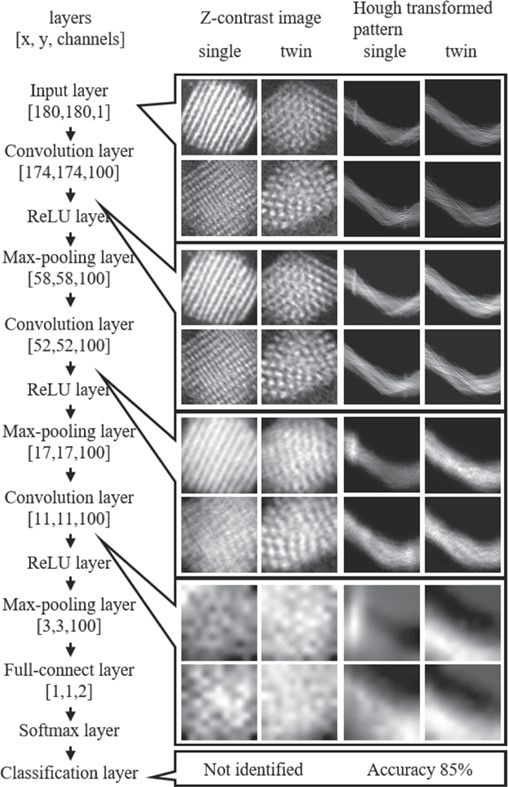-
PDF
- Split View
-
Views
-
Cite
Cite
Yuta Yamamoto, Junya Ohyama, Atsushi Satsuma, Nobuo Tanaka, Shunsuke Muto, SM-1
Identification of Z-contrast image of twinned catalytic gold nanoparticles processed by Hough transformation using convolutional neural network, Microscopy, Volume 68, Issue Supplement_1, November 2019, Page i5, https://doi.org/10.1093/jmicro/dfz054Close - Share Icon Share
Deep learning (DL), where artificial intelligence (AI) builds connection weights between neural network multi-layers for recognition, prediction, and other functions by itself on the basis of iterative learning, has attracted significant attention as an alternative image authentication method [1]. Convolutional neural networks (CNN), one of the DL algorithms developed in the 1980s [2], are a pioneer of the latest DL progress in image identification applications, replacing several layers of neural networks that are fine-adjusted by the professional human effort [3].
Supported Au nanoparticles (AuNPs) with diameters of less than 5 nm showing high catalytic activity towards CO oxidation can exhibit high catalytic activity if they contain more twinned rather than single-crystal AuNPs [4,5]. As an automatic identification method for twin AuNPs in its crystal structure was desired, the our research group demonstrated the successful identification of twinned/untwinned catalytic AuNP using a self-prepared CNN trained using Hough transformed (HTed) atomic resolution Z-contrast images of supported AuNPs [6]. In this study, the primary success factors for this identification are investigated.
The figure shows the successful CNN network architecture on the left side and visualized graphics of the strongest CNN activations in the input layer and each convolution layer by typical Z-contrast images of single/twinned AuNP and its HTed patterns on the right side. In the third convolution layer, as each HTed single AuNP shows a vertical streak pattern originating from localized signature spots arranged in tandem, which is not indicated in the HTed twinned AuNP, the CNN is proposed in order to recognize them. In contrast, the CNN cannot discriminate single AuNP Z-contrast images from twinned ones because these develop similar patterns without the feature of the lattice fringes direction; these were originally different in Z-contrast images through the network

CNN network architecture (left side) and visualized graphics of the strongest CNN activations in the input layer and each convolution layer by typical Z-contrast images of single/twinned Au nanoparticles and their Hough transformed patterns (right side).
1. Y LeCun et al., Nature 521 (2015) 436-444.
2. K Fukushima, Biol. Cybernetics 36 (1980) 193-202.
3. A Krizhevsky et al., NIPS'12 Proceedings (2012) 1097-1105.
4. A D Pandey et al., J. Phys. Chem. C 114 (2010) 19386-19394.
5. J Ohyama et al., Chem. Commun. 51 (2015) 15823-15826.
6. Y Yamamoto et al., Microscopy 67 (2018) 321-330.



